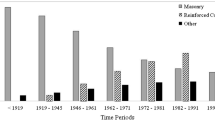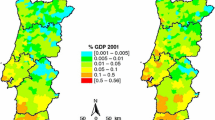Abstract
One major issue in the aftermath of a strong earthquake is the emergency management, which cannot be guaranteed if the physical components necessary for the operability of the contingency plan are either damaged, unusable or inaccessible. In order to assess the physical efficiency of the emergency system on which a contingency plan is based, the I.OPà.CLE method (Indices for evaluation of the Operational efficiency of Limit Condition Emergency) has been set up by the Italian Civil Protection Department. It is basically aimed at supporting civil protection decision makers in evaluating emergency systems and establishing strategies and priorities concerning strengthening interventions at national, regional or municipality level. The method must be potentially applied to any of the around 8000 municipalities all over Italy, and then it must refer to a minimum information dataset readily available for any municipality. Therefore, I.OPà.CLE has been specifically tailored for the minimum standard information that is provided by the analysis of Limit Condition for Emergency, as formulated in 2012 by the Italian Civil Protection Department. This analysis defines the standard framework of the physical layout of a municipal seismic emergency plan, relying on a limited number of information. Notwithstanding the numerically extensive target and limited amount of information available, the ambition of I.OPà.CLE is to perform simplified analyses without renouncing to rigor in the methodology. The present paper illustrates the analytic formulation of I.OPà.CLE and its capabilities, as well as two real examples. In the conclusion, future upgrading of the model are discussed, even in relation to the availability of further pieces of information.












Similar content being viewed by others
References
Albarello D, Mucciarelli M (2002) Seismic hazard estimates using ill-defined macroseismic data at site. Pure Appl Geophys 159:1289–1304
Braga F, Dolce M, Liberatore D (1982) Southern Italy November 23, 1980 earthquake: a statistical study on damaged buildings and an ensuing review of the M.S.K.-76 Scale. In: Proceedings of 7th European conference on earthquake engineering. CNR-PFG. 503
Commission for seismic microzonation (2014) Manuale per l’analisi della Condizione Limite per l’Emergenza (CLE) dell’insediamento urbano. draft 1.0. Betmultimedia, Rome, pp 154–175
Commissione tecnica per la Microzonazione sismica (2016). Analisi della CLE, statistiche 2016. http://www.protezionecivile.gov.it/resources/cms/documents/Allegato_5_Stat_CLE_2016_def.pdf
Crowley H, Pinho R, Keller N (2013) Assessing global earthquake risks: the global earthquake model (GEM) initiative. In: Tesfamariam S, Goda K (eds) Handbook of seismic risk analysis and management of civil infrastructure systems. Woodhead Publishing Limited, Cambridge, pp 815–838
D’Amico V, Albarello D (2008) SASHA: a computer program to assess seismic hazard from intensity data. Seismol Res Lett 79:663–671
Di Pasquale G, Orsini G (1997). Proposta per la valutazione di scenari di danno conseguenti ad un evento sismico a partire dai dati Istat. In: Proceedings of 8th Congress L’ingegneria Sismica in Italia organized by ANIDIS, Taormina, Italy, 21–24 September
Di Pasquale G, Orsini G, Romeo R (2000) Sensitivity analysis in seismic risk assessment. In: Proceedings of the 6th international conference on seismic zonation. Palm Springs, CA
Dijkstra EW (1959) A note on two problems in connection with graphs. Numerische Math 1:269–271
Dolce M (2012b) The Italian national seismic prevention program. In: Proceedings of the 15th world conference on earthquake engineering. Lisbon, September 24–28
Dolce M, Speranza E (2007) Vulnerabilità sismica del costruito. In: Regione Marche INGV (ed) Scenari di pericolosità sismica della fascia costiera marchigiana: la microzonazione sismica di Senigallia
Dolce M, Marino M, Masi A, Vona M (2000) Seismic vulnerability analysis and damage scenarios of Potenza Town. In: Proceedings of international workshop on seismic risk and earthquake damage scenarios of Potenza. Potenza, Italy, November 13
Dolce M, Di Pasquale G, Speranza E, Fumagalli F (2012a) A multipurpose method for seismic vulnerability assessment of urban areas. In: Proceedings of the 15th world conference on earthquake engineering. Lisbon, September 24–28
Dolce M, Speranza E, Dalla Negra R, Zuppiroli M, Bocchi F (2013a) Constructive features and seismic vulnerability of historic centres through the rapid assessment of historic building stocks. The experience of Ferrara. In: International conference built heritage 2013, monitoring conservation management, Polytechnic University of Milan, November 18–20
Dolce M, Speranza E, Di Pasquale G, Giordano F, Bocchi F (2013b) Indici di operatività per la valutazione della condizione limite di emergenza (CLE). In: Proceedings of XXXII GNGTS National Congress. Trieste, pp 382–389
Dolce M, Speranza E, Bocchi F, Conte C (2017a) Il metodo I.OPà.CLE per la formulazione ed il calcolo di Indici di Operatività per la valutazione della Condizione Limite di Emergenza. In: Proceedings of the 17th Congress L’ingegneria Sismica in Italia, organised by ANIDIS, Pistoia, Italy, September 17–21
Dolce M, Speranza E, Bocchi F, Conte C (2017b) Indici di Operatività per la valutazione della condizione Limite di Emergenza (I.OPà.CLE): risultati della sperimentazione. In: Proceedings of the 17th congress L’ingegneria Sismica in Italia, organised by ANIDIS, Pistoia, Italy, September 17–21
Dolce M, Speranza E, Giordano F, Borzi B, Bocchi F, Conte C, Di Meo A, Faravelli M, Pascale V (2017c) Da.D.O—Uno strumento per la consultazione e la comparazione del danno osservato relativo ai più significativi eventi sismici in Italia dal 1976. Proceedings of the 17th Congress L’ingegneria Sismica in Italia, organised by ANIDIS, Pistoia, Italy, September 17–21
DPC (2005a) Linee guida per l’individuazione delle aree di ricovero per strutture prefabbricate di protezione civile (Direttiva del Presidente del Consiglio dei Ministri, pubblicata nella GU n.44 del 23 Febbraio 2005). http://wwww-protezionecivile.gov.it/cms/attach/editor/aree DiRicovero/A1-Linee_guida.pdf
DPC (2005b) Manuale tecnico per l’allestimento delle aree di ricovero per strutture prefabbricate di protezione civile (Decreto del Capo del Dipartimento della protezione civile 24 marzo 2005, 1243). http://wwww-protezionecivile.gov.it/cms/attach/a2manuale_pubblicazione_modif.pdf
DPC (2007) Manuale operativo per la predisposizione di un piano intercomunale o comunale di protezione civile (sugli incendi boschivi). http://wwww-protezionecivile.gov.it/resources/cms/documents/Manuale.pdf
FEMA (1999) HAZUS earthquake loss estimation methodology. Technical manual, prepared by the national institute of building sciences for the federal emergency management agency, Washington DC
FEMA (2003) HAZUSMH MR4 multi-hazard kiss estimation methodology—earthquake model technical manual FEMA and NIBS, Washington DC
Ferlito R, Pizza A (2011) Modello di vulnerabilità del centro urbano. Metodologia per la valutazione speditiva della vulnerabilità della viabilità di emergenza. Ingegneria Sismica XXVIII 4:31–49
Franchin P (2014) A computational framework for systemic seismic risk analysis of civil infrastructural systems. In: Pitilakis K, Franchin P, Khazai B, Wenzel H (eds) Syner-G, methodology and applications, geotechnical, geological and earthquake engineering, vol 31. Springer, Dordrecht, pp 21–56
Franchin P, Lupoi A, Pinto PE (2006) On the role of road networks in reducing human losses after earthquakes. J Earthq Eng 10(2):195–206
Giovinazzi S, Wilson T, Davis C, Bristow D, Gallagher M, Schfield A, Tung A (2011) Lifelines performance and management following the 22 February 2011 Christchurch earthquake, New Zeland: highlights of resilience. Bull N Z Soc Earthq Eng 44(4):402–417
Goretti A (2004) Interazione tra Componenti del Sistema Urbano: la Rete Viaria, gli Edifici, l’Emergenza. In: Proceedings of 11th Congress L’ingegneria Sismica in Italia organized by ANIDIS, Genoa, Italy. January 25–29
Grunthal G (1998) European Macroseismic Scale 1998. Cahiers du Centre Europeén de Géodynamique et de Séismologie. Conseil de l’Europe (15), pp 1–99
INU (ed) (2013) Strategie di mitigazione del rischio sismico e pianificazione—CLE: Condizione Limite per l’Emergenza. Urbanistica Dossier
Menonia S, Pergalani F, Boni MP, Petrini V (2002) Lifelines earthquake vulnerability assessment: a systemic approach. Soil Dyn Earthq Eng 22:1199–1208
Modaressi H, Desramaut N, Gehl P (2014) Specification of the vulnerability of physical systems. Syner-G, methodology and applications. In: Pitilakis K, Franchin P, Khazai B, Wenzel H (eds) Geotechnical, geological and earthquake engineering, vol 31. Springer, Dordrecht, pp 131–184
Pitilakis K, Crowley H, Kaynia AM, Wenzel H (eds) (2014) SYNER-G: systemic seismic vulnerability and risk assessment of complex urban, utility, lifeline system and critical facilities. Geotechnical, geological and earthquake engineering, vol 31. Springer, Dordrecht
Sanchez-Silva M, Gomez C (2013) Risk assessment and management of civil infrastructure networks: a systems approach. In: Tesfamariam S, Goda K (eds) Handbook of seismic risk analysis and management of civil infrastructure systems, vol 4. Woodhead Publishing Limited, Cambridge, pp 437–464. https://doi.org/10.1533/9780857098986.4.437
Acknowledgements
The authors wish to thank the whole Italian Microzonation Commission, and particularly Regional Institutions involved, which allowed experimental applications of I.OPà.CLE for calibration purposes to be made; Dario Albarello who provided specific elaborations concerning the improvement of the hazard model; Gianluca Acunzo for his invaluable help in adapting Dijkstra algorithm to the specific needs.
Author information
Authors and Affiliations
Corresponding author
Rights and permissions
About this article
Cite this article
Dolce, M., Speranza, E., Bocchi, F. et al. Probabilistic assessment of structural operational efficiency in emergency limit conditions: the I.OPà.CLE method. Bull Earthquake Eng 16, 3791–3818 (2018). https://doi.org/10.1007/s10518-018-0327-7
Received:
Accepted:
Published:
Issue Date:
DOI: https://doi.org/10.1007/s10518-018-0327-7




